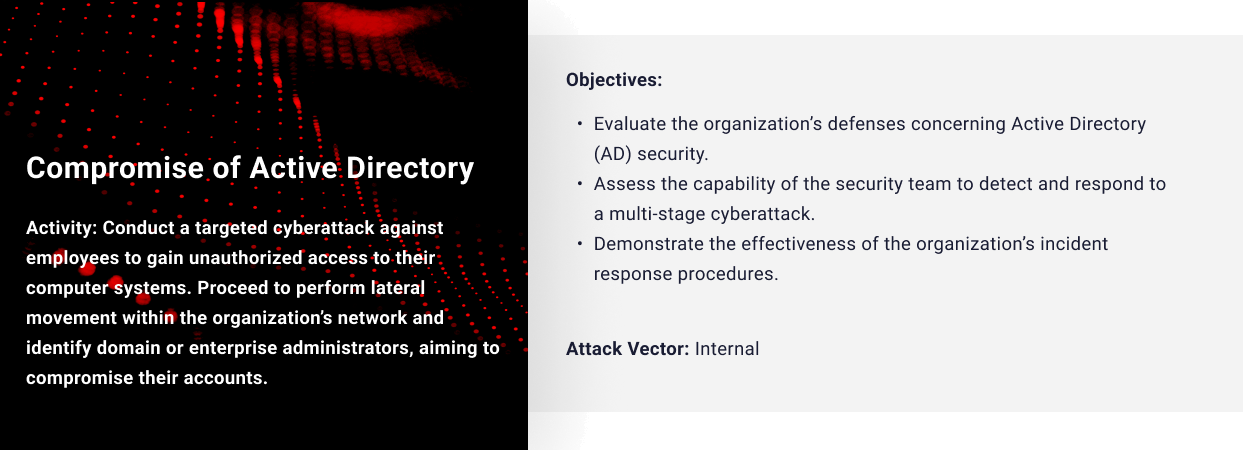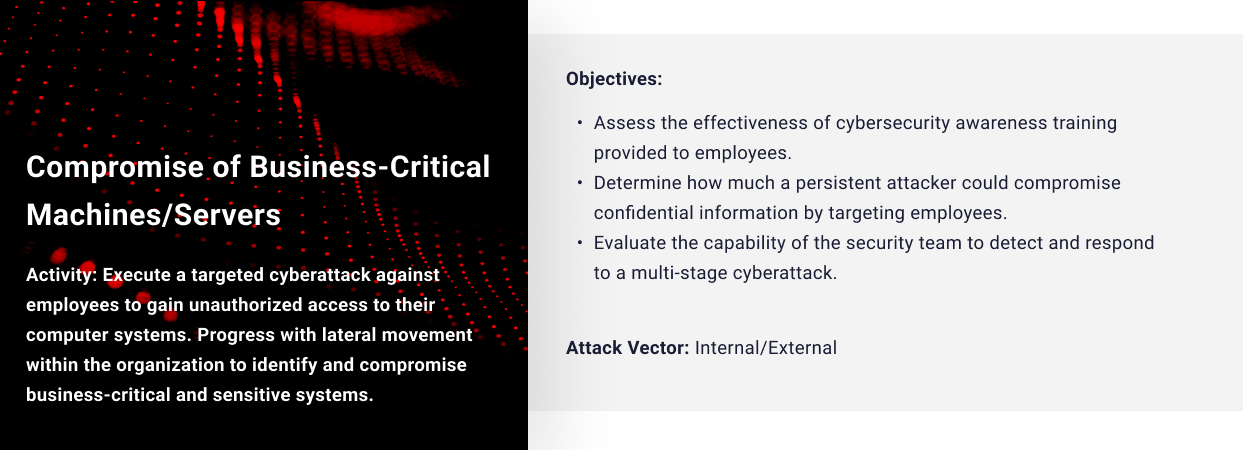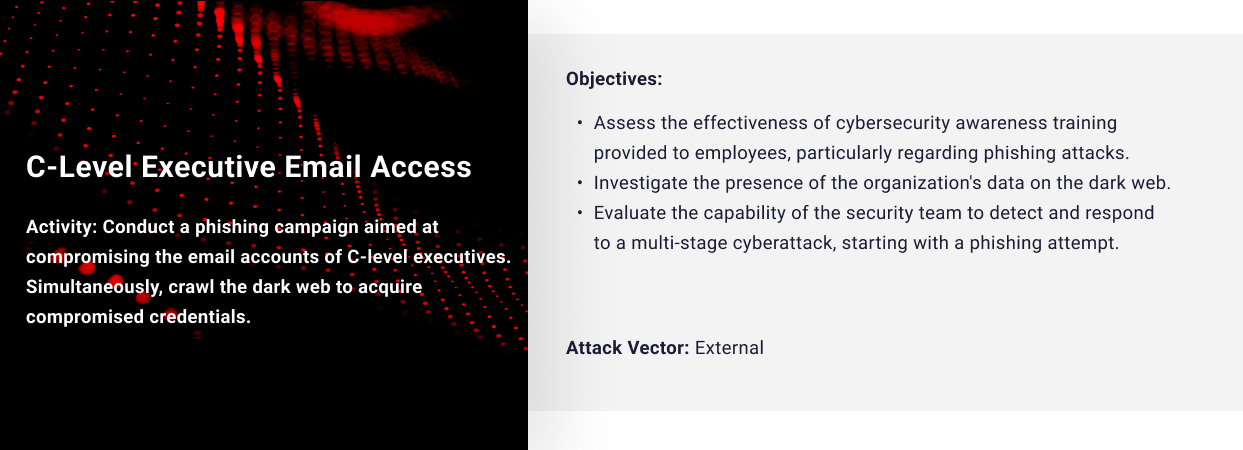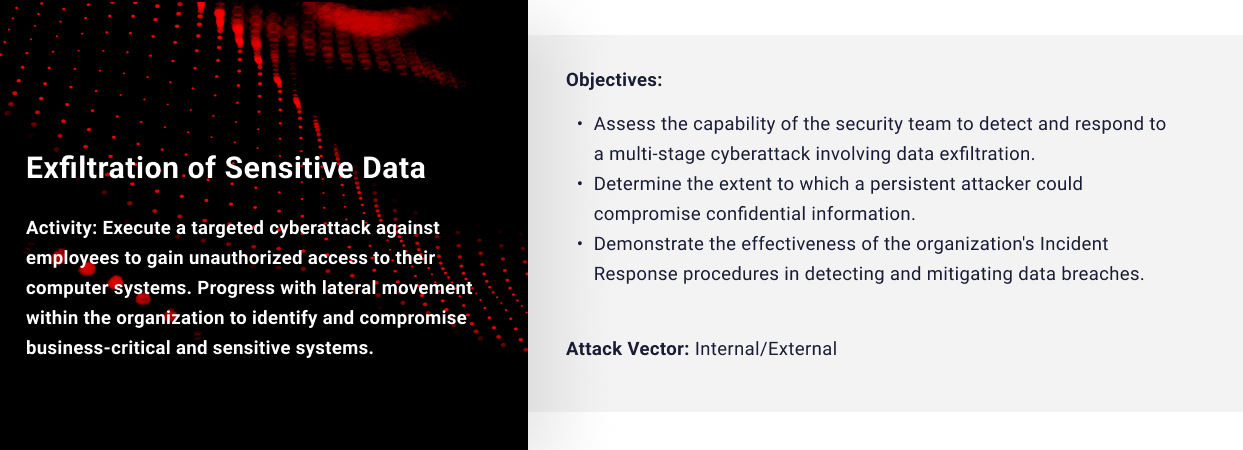Red Teaming Assessment
Red Teaming is a comprehensive security assessment where ethical hackers aim to uncover potential security gaps, demonstrating how attackers combine unrelated exploits to access sensitive data and critical assets. These highly skilled security professionals take on the role of attackers to assess the effectiveness of an organization’s defensive measures. Following the assessment, the team provides recommendations and plans to bolster the organization’s security posture, ensuring it remains resilient in the face of evolving threats.
Why Do You
Need Red Teaming?
Why Do You Need Red Teaming?
At its core, Red Teaming is more than just a security assessment; it’s a simulation of real-world cyber-attacks aimed at identifying weaknesses in an organization’s defenses. Unlike conventional penetration testing, which is defined by its scope, Red Teaming adopts a holistic approach by emulating the tactics, techniques, and procedures (TTPs) used by real-world attackers. This realistic simulation provides invaluable insights into an organization’s security posture, helping to uncover vulnerabilities that may go undetected through traditional means.

Why Should You Invest in Red Teaming If You Are Already Doing Penetration Testing?
The answer lies in the dynamic nature of cyber threats and the need for proactive defence measures. In today’s rapidly evolving threat landscape, cyber adversaries are constantly innovating and adapting their tactics to bypass conventional security controls.
01
Realistic Threat Simulation
By mimicking the tactics of actual adversaries, Red Teaming provides invaluable insights into an organization’s readiness to withstand sophisticated attacks. It also includes phishing which is used to assess an organization’s vulnerability to deceptive attacks. Through crafted emails or messages, the team gauges employee responses, identifies weaknesses in training, and strengthens incident response protocols.
02
Identification of Vulnerabilities
Organizations can better understand their vulnerabilities and strengths, allowing them to pre-emptively address weaknesses before they are exploited by malicious actors.
Accorian’s Red Teaming Methodology
Accorian utilizes the F3EAD methodology integrated with the MITRE ATTACK framework, employing a systematic approach consisting of distinct phases: Find, Fix, Finish, Exploit, Analyze, and Disseminate. Each stage is vital for successfully executing a red team assessment and realizing the objectives. In conclusion, Red Teaming assessment is not just a cybersecurity best practice but a strategic imperative for organizations looking to stay ahead of evolving threats. By partnering with Accorian, organizations can harness the power of Red Teaming to fortify their defences, safeguard their digital assets, and maintain a competitive edge in today’s cyber landscape. Don’t wait until it’s too late—take proactive steps to protect your organization with Red Teaming assessment from Accorian.
Find
In the Find phase, reconnaissance activities aim to identify targets and crown jewels. This phase sets the stage for the subsequent steps in the assessment by laying the groundwork for target selection and strategic goal-setting discussions with the organization.
Fix
In the Fix phase, the focus involves intense reconnaissance and intelligence collection against the selected target, delving into the intricacies of the target's systems, networks, and potential points of exploitation. This step is vital in the Red Team assessment process, aiming to attain a level of familiarity with the target that facilitates informed decision-making in subsequent phases of the F3EAD methodology.
Finish
In the Finish phase, the focus shifts to setting plans into action by deploying Tactics, Techniques, and Procedures (TTPs) in a decisive and coordinated manner. This phase integrates various elements, including toolsets, intelligence, capabilities, and human expertise, amalgamating into a comprehensive and potent weapon system. It’s the focal point where planning and reconnaissance transition into practical and impactful actions. MITRE ATTACK TTPs are pivotal in shaping the attack path and enhancing the red team's ability to navigate and exploit vulnerabilities effectively.
Exploit
In the exploitation phase, Accorian acts as the Red Team actor and operationalizes the detailed attack plan into action to achieve mission objectives. This phase represents the culmination of strategic planning and the initiation of exploits to realize Red Team objectives.
Analyze
In the analysis phase, the team gains insights into the systems' responses; they can adjust their tactics and techniques accordingly. This phase involves continuous updates, revisions, and modifications to the attack path and exploitation strategies. Whether an exploit succeeds or fails, the iterative nature of the phase ensures that our testers remain agile and responsive to evolving conditions.
Disseminate
In the dissemination phase, raw assessment data is transformed into actionable intelligence, acting as a vital link between the Red Team's activities and the broader organizational context. This documentation provides:
- A comprehensive record of the assessment's results
- Guides organizations with the next steps, empowering leadership for strategic decision-making
- Fortifies the overall security posture
Access Our All-In-One Red Teaming Brochure
Why Choose Accorian?
In the fast-paced world of cybersecurity, choosing the right partner is like conducting a symphony of precision and skill. We have built a trusted name in the cybersecurity sector, recognized for our prestigious CREST accreditation and unmatched expertise.
At Accorian, we take pride in our team of elite technology and cybersecurity experts. Our team is handpicked and highly skilled, establishing new standards of excellence within the industry. But it is our commitment to providing bespoke solutions that truly sets us apart.
We don’t believe in a one-size-fits-all approach. Instead, we tailor strategies to serve the specific needs of the client. This dedication towards customization fuels our remarkable 96% success rate, ensuring that what we have to offer will most definitely match the demands set by the business world nowadays.
At Accorian, we deliver realistic Red Team Exercises to identify vulnerabilities before they can be exploited. By simulating real-world attack scenarios, we thoroughly evaluate an organization’s defenses, uncover hidden weaknesses, and show how multiple exploits could breach security. Our actionable insights and tailored recommendations significantly enhance our clients' security posture, helping them stay resilient against evolving threats.
Accorian’s Key Differentiators
We leverage our automated scanners & tools along with our custom scripts to conduct thorough assessments and ensure comprehensive coverage
Combined experience of working with 500+ clients on 2100+ penetration tests, detection of 25000+ vulnerabilities, & 100% success rate in red team engagements
A Trusted Vulnerability Assessor & an Approved Scan Vendor (ASV) for organizations in sectors such as bank financial services, credit unions, eCommerce, & SaaS that need to adhere to PCI DSS requirements
Our test plans aim to cover 200-400 checks for network penetration tests and 400-800 reviews for application penetration tests
Our time-tested and proven penetration testing methodology is built using OSSTMM, OWASP, NIST, & PTES standards
End-to-end project management for assessments with comprehensive & detailed reporting through our platform










